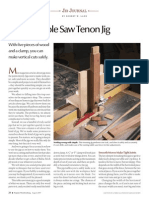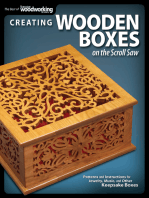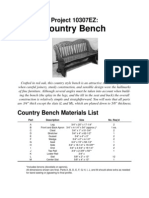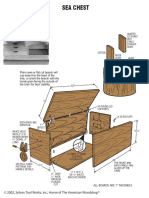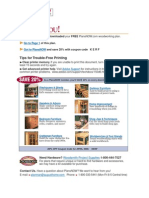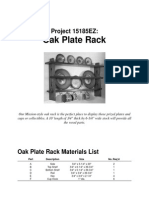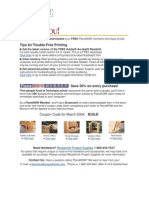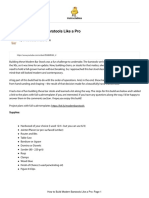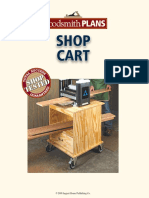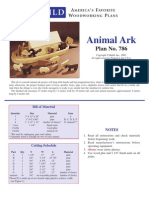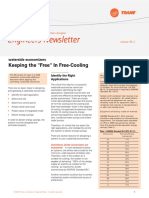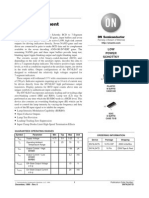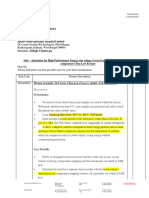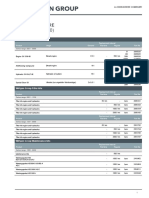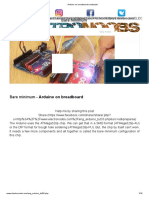Easy Resawing: The Fence. The Fence
Easy Resawing: The Fence. The Fence
Uploaded by
BilAndersenCopyright:
Available Formats
Easy Resawing: The Fence. The Fence
Easy Resawing: The Fence. The Fence
Uploaded by
BilAndersenOriginal Description:
Original Title
Copyright
Available Formats
Share this document
Did you find this document useful?
Is this content inappropriate?
Copyright:
Available Formats
Easy Resawing: The Fence. The Fence
Easy Resawing: The Fence. The Fence
Uploaded by
BilAndersenCopyright:
Available Formats
Easy Resawing
By George Vondriska
In my experience, resawing on the bandsaw is one of those
things that makes smoke come out of woodworkers ears. It
can, admittedly, be tough to get perfect, especially if you have
to go through the steps required for drift compensation.
(Sometimes you get the drift, sometimes you dont.)
Heres whatll save your resaw bacon. You dont always have to
do drift compensation. The key to dirt simple resawing is a
singe point contact fence, which you can easily make.
The Fence. The fence
is simple. Use 1/2! ply-
wood for the base, face,
and brace. Use 3/4!
hardwood for the con-
tact point. The height
of the face should be
close to the width of
the material youll be
resawing. Your best bet is to make a few of these, in 2! increments, so you have fences for
narrow, medium, and wide stock.
The base should as long as your bandsaw table is deep, or
a little more. The brace needs to be cut at a perfect 90-
degrees. The hole is for hanging the fence up when youre
done.
Make the contact point
by easing two corners
with a 3/8! roundover
bit, which produces a
bull nose. Do this to a
piece thats wider and
longer than what you
need for the fence. Rip and crosscut it to final size after the roundover is complete. Its OK
to make this piece from thinner or thicker stock to match the roundover bit you own. The
important thing is getting a bull nose so you create a single contact point.
Choose the right blade. While a 1/4! blade is fine
for cutting curves, you need something wider for
resawing. Use a blade thats at least 1/2! wide,
with 3 or 4 teeth per inch. Resawing is a ripping
operation, and requires aggressive teeth to carry
the waste out of the cut.
Set the camber on the upper wheel to position the
blade in the center of the tire.
The thrust bearing should be .003! (the thickness of a
piece of paper) behind the blade. Steel guide blocks or
bearings should be .003! away from the side of the blade.
Composite guide blocks can be allowed to kiss against the
side of the blade. Make sure you check the set up above
and below the table.
Mark Your
Boards. Youll
need to mark
each piece you
want to resaw (a
downside to this
process). I do this
by locating the
cut on the edge of
the board and,
using a pencil and my finger as a marking gauge, mark a line down the length. You can
also use a straight edge or marking gauge to do this.
Position The Fence. The fence needs to be posi-
tioned front to back and left to right. The front to
back setting is correct when the contact point is
1/4! in front of the teeth of the blade. Its impor-
tant that the material touches the contact point be-
fore it touches the blade.
To position the fence left to right, align the mark
you made in the previous step with the blade.
Clamp one end of your single point fence to the bandsaw
table and confirm that the position is correct.
Clamp the oppo-
site end.
Making The
Cut. Using a
push pad to hold
the material
against the fence,
push the piece
forward into the
blade.
Youll need to
steer as you
cut, keep-
ing the
blade on
your pencil
line.
As you near
the end of
the cut its
safer to pull the material than push it.
Why Resaw At All? One
great reason to resaw is book
matching. These two pieces
are perfect mirrors of each
other because they were cut
from the same board by
resawing.
You may also resaw simply
because of economics. Got a
project that calls for thin
pieces? Instead of planing to thickness and sending much of your material into the dust
collector, resaw first to get the pieces close.
The Negatives to Single Point. Alright, theres no such thing as a free lunch, or a free
resaw. A few downsides to resawing with a single point fence;
You need to mark every piece youre going to cut.
You cant just ride the material against the fence and go, you need to steer as you cut.
This does provide an opportunity to screw up.
If youre resawing pieces to various sizes youll need to move and reclamp the fence
for each cut.
Bottom line? If Im resawing a board or two I put my single point fence on the saw. If Im
cutting lots of pieces or making a demanding cut, such as cutting thin veneer, I use my
conventional fence and do a drift compensation.
Photos By Author
Related Video:
Band Saw Resawing
All Woodworking Articles, One Great Tip
Resawing, Resawing Boards
You might also like
- Pine Desk Organizer: Project 13782EZDocument6 pagesPine Desk Organizer: Project 13782EZBSulli100% (1)
- 1990 1 JanFebDocument25 pages1990 1 JanFebRocio Mtz100% (1)
- 03ANDocument515 pages03ANGregory hughesNo ratings yet
- WG20 Instalation Manual AnDocument44 pagesWG20 Instalation Manual Anluisgabrielperez80% (5)
- Types of Joints in Carpentry With DescriptionDocument5 pagesTypes of Joints in Carpentry With DescriptionYuuki ChanNo ratings yet
- 24-25 - AUG07PW - Jig Journal PDFDocument2 pages24-25 - AUG07PW - Jig Journal PDFzazoumobile6218100% (1)
- Creating Wooden Boxes on the Scroll Saw: Patterns and Instructions for Jewelry, Music, and Other Keepsake BoxesFrom EverandCreating Wooden Boxes on the Scroll Saw: Patterns and Instructions for Jewelry, Music, and Other Keepsake BoxesRating: 5 out of 5 stars5/5 (1)
- Boxes to Build: Sturdy & Stylish Projects to Organize Your Home & ShopFrom EverandBoxes to Build: Sturdy & Stylish Projects to Organize Your Home & ShopNo ratings yet
- The Essential Handsaw Book: Projects & Techniques for Mastering a Timeless Hand ToolFrom EverandThe Essential Handsaw Book: Projects & Techniques for Mastering a Timeless Hand ToolNo ratings yet
- Wall Hung Magazine and Book Rack: Project 14211EZDocument3 pagesWall Hung Magazine and Book Rack: Project 14211EZBSulliNo ratings yet
- Plansnow FlatstockjointerDocument3 pagesPlansnow FlatstockjointerFelipe AltamiranoNo ratings yet
- Hank Ou: Get More From Your Table SawDocument6 pagesHank Ou: Get More From Your Table Sawasg0401No ratings yet
- Creating A Ring HolderDocument3 pagesCreating A Ring Holderapi-522254901No ratings yet
- Classic Flag Case: © 2014 August Home Publishing CoDocument11 pagesClassic Flag Case: © 2014 August Home Publishing Cokostas1977No ratings yet
- Small Colonial Bench: Project 10297EZDocument5 pagesSmall Colonial Bench: Project 10297EZmhein68No ratings yet
- Dovetailed Tool BoxDocument13 pagesDovetailed Tool Boxdavid100% (1)
- Disc Sander Circle JigDocument1 pageDisc Sander Circle JigFrancois VaaltynNo ratings yet
- Adega ModularDocument15 pagesAdega ModularJairoViolinistaNo ratings yet
- Sash PlanesDocument5 pagesSash PlanesBlakdawg15100% (1)
- Country Bench: Project 10307EZDocument8 pagesCountry Bench: Project 10307EZBSulliNo ratings yet
- Sea ChestDocument2 pagesSea ChestAnninha Sud AlvesNo ratings yet
- Veneered End Table: Project 17901EZDocument4 pagesVeneered End Table: Project 17901EZBSulliNo ratings yet
- Jig For Threaded Inserts: Nline XtrasDocument1 pageJig For Threaded Inserts: Nline XtrasJd Diaz100% (1)
- Garys Making A Coffin Smoothing PlaneDocument24 pagesGarys Making A Coffin Smoothing PlaneBenjamin LunaNo ratings yet
- Bandsaw Circle JigDocument3 pagesBandsaw Circle Jigphilipisaia100% (1)
- Coffe TableDocument15 pagesCoffe TableJun Vargas100% (1)
- Contemporary Coffee Table: Project 17631EZDocument5 pagesContemporary Coffee Table: Project 17631EZBSulliNo ratings yet
- Plansnow DownloadDocument4 pagesPlansnow DownloadJimmy Gomez100% (1)
- 2 - Woodworking Plans - OakplateDocument6 pages2 - Woodworking Plans - OakplatemacpatorNo ratings yet
- (Magazine - Wood - Eng) Woodsmith #100 Vol 17 (Aug 1995) Classic Workbench - (Special Edition) PDFDocument30 pages(Magazine - Wood - Eng) Woodsmith #100 Vol 17 (Aug 1995) Classic Workbench - (Special Edition) PDFPaweł JamrożekNo ratings yet
- WOOD Store: Thank You!Document12 pagesWOOD Store: Thank You!lacroitoruNo ratings yet
- 101 - Stub Tenon and Groove JoineryDocument3 pages101 - Stub Tenon and Groove JoineryRob Pierce100% (1)
- Wall-Hung Telephone Cabinet: Project 11257EZDocument6 pagesWall-Hung Telephone Cabinet: Project 11257EZBSulli100% (1)
- Pine Cabinet: Project 11142EZDocument5 pagesPine Cabinet: Project 11142EZBSulliNo ratings yet
- Çalışma Tezgahı PlanıDocument14 pagesÇalışma Tezgahı PlanıÖmür Eryüksel50% (2)
- Fast FixesDocument3 pagesFast FixesGsmHelpNo ratings yet
- Wood Working Plans - Toys - Rocking Horse PDFDocument6 pagesWood Working Plans - Toys - Rocking Horse PDFBen GerezNo ratings yet
- Leg Tapering Jig: Project 14585EZDocument5 pagesLeg Tapering Jig: Project 14585EZBSulliNo ratings yet
- Stacking Desk Tray: Project 19874EZDocument4 pagesStacking Desk Tray: Project 19874EZBSulliNo ratings yet
- Carpentry Tools: National College of Science and TechnologyDocument23 pagesCarpentry Tools: National College of Science and TechnologyKC PanerNo ratings yet
- Plansnow MilkpaintDocument3 pagesPlansnow MilkpaintTa JavoNo ratings yet
- Armario de ParedeDocument4 pagesArmario de ParedetovenoNo ratings yet
- FinishDocument4 pagesFinishGsmHelpNo ratings yet
- Bench - Mendocino BenchDocument5 pagesBench - Mendocino BenchvdbrogerNo ratings yet
- SN 100 - Reducing Rod DiameterDocument1 pageSN 100 - Reducing Rod DiameterHomerSimsonnakisNo ratings yet
- Valet StandDocument9 pagesValet StandflerziNo ratings yet
- Stowaway Bench: Woodworks: Intermediate ProjectDocument8 pagesStowaway Bench: Woodworks: Intermediate Projectfdarela100% (1)
- DIYPete Rolling Workbench PlansDocument15 pagesDIYPete Rolling Workbench PlansNoahNo ratings yet
- Loose-Tenon Options: Spend A Little, Spend A Lot: Three Great Ways To Make Loose-Tenon JointsDocument6 pagesLoose-Tenon Options: Spend A Little, Spend A Lot: Three Great Ways To Make Loose-Tenon JointsFausto Martin Vicente MoralesNo ratings yet
- Kreg Multipurpose Work CenterDocument14 pagesKreg Multipurpose Work CenterMiguel Angel Garcia de la Rosa100% (1)
- April 2004: Opular OodworkingDocument4 pagesApril 2004: Opular OodworkingMark BehmNo ratings yet
- Hollows and RoundsDocument3 pagesHollows and RoundsMitch ArchNo ratings yet
- Woodcraft Magazine - October-November 2020Document70 pagesWoodcraft Magazine - October-November 2020Adrian SeketaNo ratings yet
- Shelving, Plain and SimpleDocument2 pagesShelving, Plain and Simplecaballo_blanco_2No ratings yet
- WS15620 Candle-HoldersDocument6 pagesWS15620 Candle-HoldersJasmine VaaltynNo ratings yet
- Mini Cross Cut SledDocument14 pagesMini Cross Cut SledNelson Young II100% (1)
- How To Build Modern Barstools Like A ProDocument17 pagesHow To Build Modern Barstools Like A Progerman100% (1)
- Shop CartDocument3 pagesShop Cartgmand68No ratings yet
- U-Bild: Animal ArkDocument8 pagesU-Bild: Animal ArkEmilian BalutaNo ratings yet
- EGS SealDocument2 pagesEGS Sealsj19330No ratings yet
- Computer FundamentalsDocument17 pagesComputer Fundamentalsdarmahnoor0% (1)
- VT2218 ECM High-Efficiency Circulator: Water Circulation Pumps & CirculatorsDocument4 pagesVT2218 ECM High-Efficiency Circulator: Water Circulation Pumps & Circulatorshamdi gshNo ratings yet
- Engineers Newsletter: Keeping The "Free" in Free-CoolingDocument8 pagesEngineers Newsletter: Keeping The "Free" in Free-CoolingJoshuaNo ratings yet
- Clark SM 718 Service ManualDocument10 pagesClark SM 718 Service Manuallinda100% (64)
- Police Light FinalDocument4 pagesPolice Light FinalDeepuNo ratings yet
- SN74LS47 BCD To 7-Segment Decoder/Driver: LOW Power SchottkyDocument8 pagesSN74LS47 BCD To 7-Segment Decoder/Driver: LOW Power SchottkyJesus AntonioNo ratings yet
- Saipem 3000Document8 pagesSaipem 3000Nkechi KokoNo ratings yet
- Cat 793D PDFDocument32 pagesCat 793D PDFmark towerNo ratings yet
- LX279 With 48C Deck: Lawn Tractor 48" Convertible DeckDocument1 pageLX279 With 48C Deck: Lawn Tractor 48" Convertible DeckManuel Fernandez Mora0% (1)
- TSX40086V - 80 FreezerDocument4 pagesTSX40086V - 80 FreezerN dasNo ratings yet
- Unit-1 - Digital ElectronicsDocument50 pagesUnit-1 - Digital ElectronicsVignesh VigneshNo ratings yet
- RIS-2500-P-EKO-S-F7: Characteristic Curve at 1.2Kg/MDocument3 pagesRIS-2500-P-EKO-S-F7: Characteristic Curve at 1.2Kg/MkirooNo ratings yet
- E-TON Vector ST 250 Vxl-250 St-Part ManualDocument53 pagesE-TON Vector ST 250 Vxl-250 St-Part ManualmariusgrosyNo ratings yet
- MHI Centrifugal Chillers: 16-5, Konan 2-Chome, Minato-Ku, Tokyo 108-8215, JapanDocument12 pagesMHI Centrifugal Chillers: 16-5, Konan 2-Chome, Minato-Ku, Tokyo 108-8215, JapanAbdulSattarNo ratings yet
- Weekly Market Report Wk2Document5 pagesWeekly Market Report Wk2Sandesh Tukaram GhandatNo ratings yet
- H181 (HD 90 - 110) PDFDocument2 pagesH181 (HD 90 - 110) PDFadrianNo ratings yet
- Daftar Hadir Dan LemburDocument24 pagesDaftar Hadir Dan LemburDidi SusantoNo ratings yet
- EEE-477 (Protective Relays) : Mrs. Helena Bulbul Deptt. of EEE, UIUDocument29 pagesEEE-477 (Protective Relays) : Mrs. Helena Bulbul Deptt. of EEE, UIUMasud SarkerNo ratings yet
- Arduino On Breadboard Bootloader PDFDocument16 pagesArduino On Breadboard Bootloader PDFKuldeep SinghNo ratings yet
- Cerrar SIS Pantalla Anterior: Truck 793F Truck SSP 793F Off-Highway Truck SSP00001-UP (MACHINE) POWERED BY C175-16 EngineDocument12 pagesCerrar SIS Pantalla Anterior: Truck 793F Truck SSP 793F Off-Highway Truck SSP00001-UP (MACHINE) POWERED BY C175-16 EngineIsrael MirandaNo ratings yet
- Planos Hidráulicos Moto Cat 140MDocument4 pagesPlanos Hidráulicos Moto Cat 140Mjuafe100% (2)
- Cabluri PretDocument37 pagesCabluri Pretpdragos9No ratings yet
- RFQ and Purchase Order Specification Work Sheets: Prismatic GagesDocument3 pagesRFQ and Purchase Order Specification Work Sheets: Prismatic Gagesjose julianNo ratings yet
- BowthorpesurgearrestersDocument15 pagesBowthorpesurgearrestersTony Daniel Aguilar AlvarezNo ratings yet
- Fused Loadbreak Elbows: ElastimoldDocument13 pagesFused Loadbreak Elbows: ElastimoldRudy MartínezNo ratings yet
- UL P92 Echo Super IPC Full - Ed1R3Document99 pagesUL P92 Echo Super IPC Full - Ed1R3Rafael RafaelNo ratings yet
- PDU Project Report 104Document11 pagesPDU Project Report 104Rana FaizanNo ratings yet






